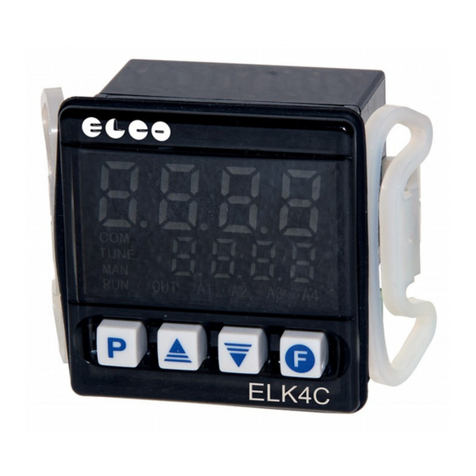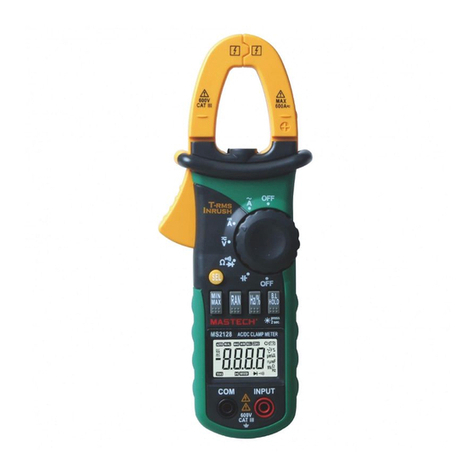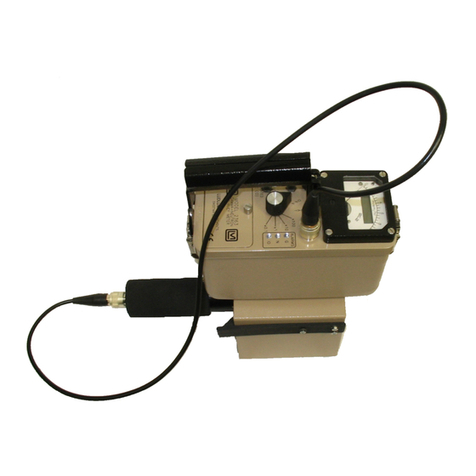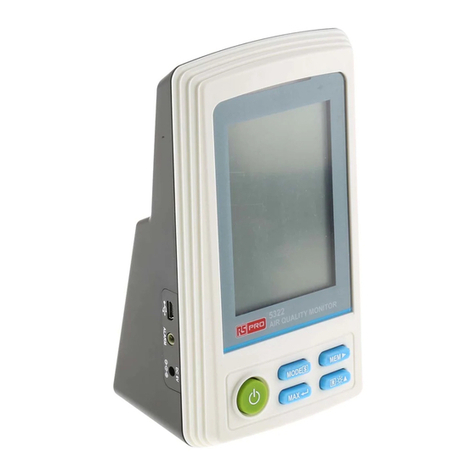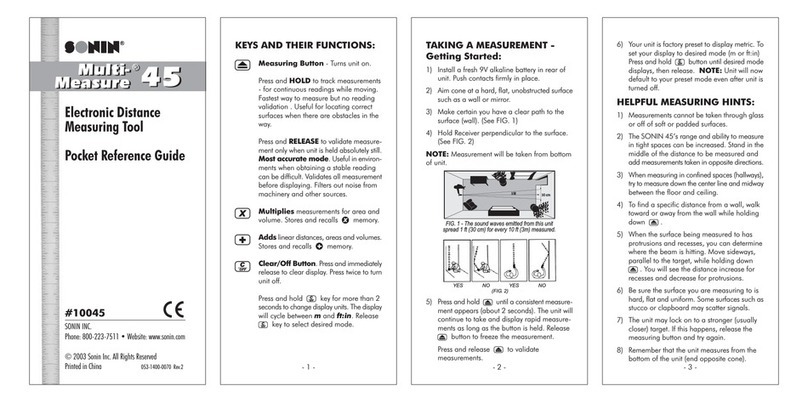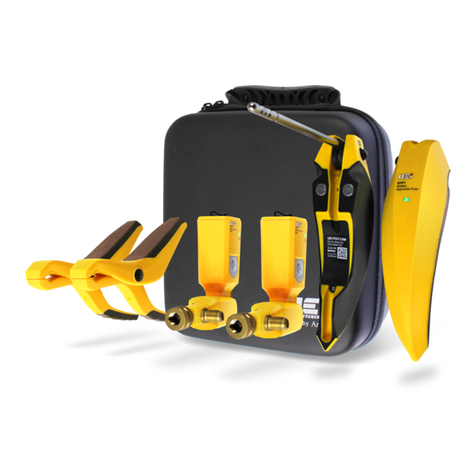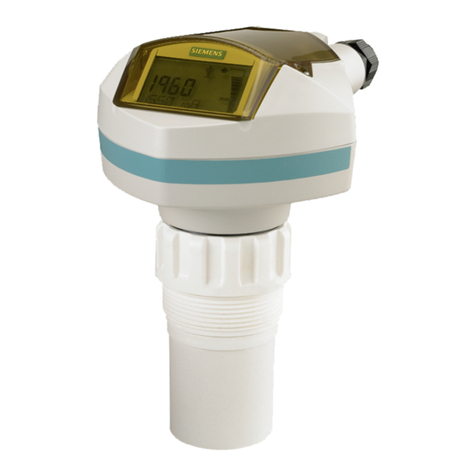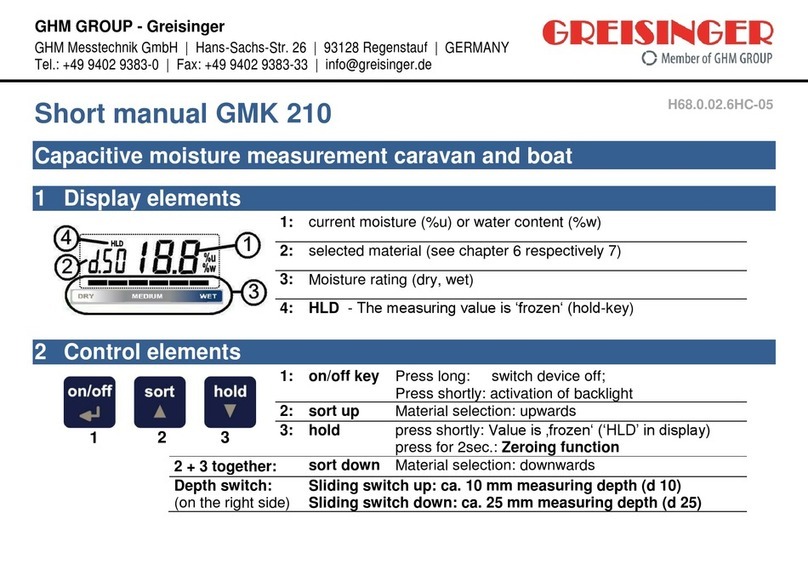elco ELM-4D1P User manual

INSTRUCTION MANUAL
IM443-U v0.7
ELM-4D1P ELECTRICAL MULTIFUNCTION METER
GENERALITY
ELM-4D1P
instruction manual
IM443-U v0.7
pag. 1
These digital multimeters allow to monitor all the electrical parameters
present on a distribution line. The local display of 30 electrical parameters
is carried out by 4 display with red LED guaranteeing a good and
contemporary reading of more measures. A simple front panel completes
the intuitive selection of several electrical parameters, with a great quantity
of information. These instruments, over of the instantaneous measures,
display the maximum peak of the main parameters (maximum peak and
maximum demand). The presence of the serial port communication
EIA485 (option) allows the connection in network of more instruments to
realize centralized measure networks.
These multimeters replace in a unique device, all the functions of
voltmeters, ammeters, energy meters, cosphimeters, wattmeters,
varmeters, frequency meters permitting a great economic saving, a reduction of dimension and the wiring energy and
a simplification in the purchase and management of the instruments because this is a model usable at all of need of
local measure in the electrical panel, machine, etc.
AVAILABLE MODELS
It’s available one model for DIN rail mounting.
- ELM-4D1P-485A basic version in execution for DIN rail mounting 35
mm with serial output (RS485) and with analog output
OPTIONS
- Power Supply: 20÷60 Vac / 24÷72 Vcc (-C1)
- Power Supply: 85÷230 Vac / 90-250 Vcc (-C2)
- Insulated current inputs (-T)
MEASURED PARAMETERS
parameters unit of measurement initial identification
phase and three phase voltages [V-kV] V L1-N V L2-N V L3-N ΣV L-N
phase to phase and three phase system voltages [V-kV] V L1-L2 V L2-L3 V L3-L1 ΣV L-L
phase and three phase currents [A-kA] A L1 A L2 A L3 ΣA
neutral current [A-kA] An
phase and three phase power factors PF L1 PF L2 PF L3 Σ PF
phase and three phase active powers [W-kW-MW] W L1 W L2 W L3 Σ W
phase and three phase system reactive powers [VAr-kVAr-MVAr] VAr L1 VAr L2 VAr L3 Σ VAr
phase and three-phase system apparent powers [VA-kVA-MVA] VA L1 VA L2 VA L3 Σ VA
frequency [Hz] Hz L1
temperature [°C] T
three phase system active energy [kWh] ΣkWh
three phase system reactive energy [kVArh] ΣkVArh
three phase system apparent energy [kVAh] ΣkVAh
hour counter [hr] h
average and peak values (maximums):
maximum phase voltages [V-kV] V L1-N max V L2-N max V L3-N m x
a
maximum phase currents [A-kA] A L1 m x A L2 max A L3 max
a
maximum neutral current [A-kA] An max
maximum three-phase powers [W-VAr-VA (k-M)] ΣW max ΣVAr max ΣVA max
maximum average phase currents (maximum demand) [A-kA] I L1 max (avg I L2 max (avg) I L3 max (avg)
)
maximum average neutral current (maximum demand) [A-kA] An max (avg)
maximum average three-phase powers (maximum demand) [W-VAr-VA (k-M)] ΣW max (avg) ΣVAr max (avg) ΣVA m x (avg)
a
average phase currents [A-kA] A L1 a g A L2 avg A L3 avg
v
average neutral current [A-kA] An avg
average three-phase powers [W-VAr-VA (k-M)] ΣW avg ΣVAr avg ΣVA avg

ELM-4D1P
instruction manual
IM443-U v0.7
pag. 2
INSTALLATION
WARNING FOR THE USER
Read carefully the instructions/indications contained in this manual before installing and using the instrument.
The instrument described in this manual is intended for use by properly trained staff only.
SAFETY
This instrument has been manufactured and tested in compliance with EN 61010-1 standards. In order to maintain these conditions
and to ensure safe operation, the person must comply with the indications and markings contained in the manual. When the
instrument is received, before beginning installation, check that it's O.K. And it has not suffered any damage during transport. When
starting installation make sure that the operating voltage and mains voltage are compatible with the device instructions. The
instrument power supply must not be earthed. Maintenance and/or repair must be carried out only by qualified and authorized
personnel. If there is ever the suspicious that, that there is a lack of safety ,during operation, the instrument must be disconnected
and cautions taken against accidental use.
Operation is no longer safe when: - The instrument doesn't work. / - The measured value are obviously wrong or
unreasonable / - There is clearly visible damage. / - After serious damage incurred during transport. / - After a storage
under unfavourable conditions
CONNECTION
For a correct use of the device, the wiring diagram contained in the present manual, must be respected.
The connections are the same for all models and are subdivided in three groups:
- auxiliary power supply:
On the instrument are available 4 terminals to connect the auxiliary power supply to the instrument:
V
ac
v
e
r
sion
V
ac
/
dc
v
e
r
sion
V
ac
/
dc
v
e
r
sion
Terminals Power Supply Terminals Power Supply Terminals Power Supply
19-20 0-110V = 100-125Vac 50-60Hz
19-21 0-230V = 220-240Vac 50-60Hz
19-23 0-400V = 380-415Vac 50-60Hz
19-21
20-60Vac
24-72Vdc
19-21
85-230Vac
90-250Vdc
It’s possible, for example, to take the auxiliary power supply between phase and neutral, in a 4 wires system, or
phase-phase in a 3 wires system, without neutral or from a VT in a medium voltage application.
- measure voltage inputs:
4 terminals are available for the connection to the 3 phase and neutral of the network of measure, the maximum
voltage phase to phase shouldn't be over 500 V rms.
In case of a 3 phase system without neutral, or non distributed neutral to leave terminal N free.
- measure current inputs:
6 terminals are available for the connection to 3 external amperometric transformers with secondary 5A, it’s possible
to use 2 TA on lines with 3 wires (insertion three phase Aron). The utilization of external TA is obligatory.
With the neutral current input option installed, the multimeter allows the measure of the neutral current, using a current
transformer /5A; the secondary must be connected to the In S1 and S2 terminals available on the rear of the
instrument (see the wiring diagram).
REMARKS: It's a must to respect the phase sequence. The connections between current and voltage phase inputs must not be
inverted (for example, CT placed on phase L1 must correspond to the I1 input). So as it is not correct to invert S1 and S2 terminals,
since power factors and powers might not be reliable.
For fixing the flush mount version instrument to the panel, use the fixing devices supplied, by inserting them in the side groves of the
enclosure and tighten the screws.
For safety reasons, place an external fuse protection at the input voltages, and use adequate cables for the working voltages and
currents, with a cross sections from 0,5 to 2,5 mm2.

WIRING DIAGRAMS
W
ELM-4D1P
instruction manual
IM443-U v0.7
pag. 3

ELM-4D1P
instruction manual
IM443-U v0.7
pag. 4
measure current
inputs
0
110
230
400
measure c t
input
urren
I2
s
I1
measure cu nt
input
rre
I2
s
I1
INSERTION ON THREE-PHASE LINE WITH 4 WIRES
measure current
inputs
0
110
230
400
0
110
230
400
0
110
230
400
measure voltage
inputs
measure voltage
inputs
measure voltage
inputs
S1
S2 auxiliary
power
supply
S1
S2
measure voltage
inputs
S1
S2
Digital
Outputs
imeasure voltage
inputs
I3
S1
ELM
S2
V
L1
V
L2
V
L3
N
Digital Input
connection
From 80 to 250
Vac
From 90 to 250
Vdc
L1
S1
L2 P1
S1
L3
P1
N
S1
S2
P1
P2
it’s better to put a fuse (50mA 250 V
fast)
on the digital
input.
The maximum current absorbed is 1
mA.
N.B. on line with 3 wires (without neutral or with neutral not supplied) the
N
terminaln must not be
connected.
INSERTION ON THREE PHASE LINE WITH 3 WIRES AND 2 CT
(AARON insertion)
(only for INSULATED CURRENT INPUTS option)
ELM
with
internalCT
S1
I1
S2 auxiliary
power
supply
S1
I2
S2
S1
ELM
I3
S2
V
L1
V
L2
V
L3
N
with
Ineutral
option
In
V
L1
V
L2
V
L3
N
L1
S1
L2
P1
L3
S1
S2
L1
L2
L3 S1
S2
N P1
P2
P1
P2
CT connection
to
Voltage insertion with 3
VT
N.B. it’s better, where possible, to use 3 CT (above all with unbalance
loads)
read the
neutral
current
INSERTION ON THREE-PHASE BALANCED WITH 3 OR 4 WIRES
S1
S2 auxiliary
power
supply
S1
S2
I3
S1
ELM
S2
V
L1
V
L2
V
L3
N
Digital
Outputs:
DO1 output if used as PULSE is linked to
the
ACTIVE ENERGY
counter,
DO2 output if used as PULSE is linked to
the
REACTIVE ENERGY
counter.
DO1 and DO2 can be used as ALARM and
they
can be linked to a
measure.
L1
S1
P1
L2
L3
N
Max
150mA
Max
230Vac/dc
N.B. on line with 3 wires (without neutral or with neutral not supplied) the
N
terminaln must not be
connected.
ELM
INSERTION ON SINGLE PHASE
L1 S1
S2
P1
P2
N
S1
I1
S2 auxiliary
power
supply
S1
I2
S2
ELM
S1
I3
S2
V
L1
V
L2
V
L3
N
N.B. If the multimeters are used on single phase line, the measure
are
referred on the L1 phase. The others datadisplayed relatives at
three
phase system are not to
consider.

ELM-4D1P
instruction manual
IM443-U v0.7
pag. 5
DESCRIPTION FRONT PANEL– OPERATORS
VA VL-L
LEGEND:
A: push-button for the visualization of electrical parameters of three-phase system with the corresponding LED
indication. In modality programming (SETUP) it’s used to confirm the parameter set.
B: push-button for the selection of the electrical parameter to be displayed on display F. In modality programming
(SETUP) it’s used to increase the value of the parameters to set.
C: push-button for the selection of the electrical parameter to be displayed on display G. In modality
programming (SETUP) it’s used to reduce the value of the parameters to set.
D: LED bar for the indication of the electrical parameter displayed on display F.
E: LED bar for the indication of the electrical parameter displayed on display G.
F: 3 displays for the visualization of electrical measures of every phase.
When ΣL LED is ON, only the main display will be active showing the three-phase system value of the
electrical measure selected.
LED k and M show the eventual multiplying factor (k = kilo=x 1.000, M =Mega= x 1.000.000)
Using the C key the display indicates also the values of the active and reactive energy counters.
Using the A and B keys the display indicates the maximum and average values.
G: display for the visualization of the electrical measure indicated in LED E (energy counters excluded).
The voltage values are referred to the three-phase system.
The k LED displays the reading in kilo (x 1000).
Using the C key the display indicates the type of the energy displayed.
Using the A and B keys the displays indicate the type of the value: average or maximum.
A+C:when pressing simultaneously the instrument pass to the following menu:
- instrument programming (
SETUP
)
- energy counters and peak values deleting (
RESET
)
- digital outputs programming (SET DO1; SET DO
2
)
- analog output programming (SET AN
OUT)
- hour counter programming (
HR_
)
- I/O diagnostic page
A+B:when pressing simultaneously the instrument pass to the visualization of average and maximum values
stored.
MENU OF INSTRUMENT PROGRAMMING (
SETUP
)
To enter in SETUP it’s necessary to press at the same time A and C keys, on the F display will appear the message
SeTUp.
Pressing the A key on the G display will appear the message SET that will remain always displayed during
the set of each parameter to highlight the setup phase in running.
The set values will be keep also in absence of auxiliary power supply.

SET GENERAL PARAMETER (SET
UP
)
Entry to menu:
seT
UP Æ
seT
Up
RESET
SET
DO1
SET
DO2
SET AN
OUT
SET
HR_
ELM-4D1P
instruction manual
IM443-U v0.7
pag. 6
DO_ OFF
OFF
SET CT Increase
Set CT ratio
from 1 to
2000
Decrease
SET VT Increase
Set VT ratio
from
0.1
to
400.0
Decrease
(version with An input) SET CTN Increase
Set CT ratio of the neutral
input from 1 a
2000
Decrease
seT AV9
T Increase
Set average time
from 1 to
30
minutes Decrease
seT
EN TB1
TB2
Set Energy visualization TOT
PAR
type
NORMAL
seT 3pH
BALANC
Set connection
UN_BAL
type 1PH
L1
seT
MDE
-3-
Set wiring connection
type
-4-
seT SYN
MDE
L1
Set synchronism
50
type
60
(version with digital output)
seT
PUL SE
10.0
kW-kVAr / pulse
Set pulse weight
01.0
kW-kVAr / pulse
0.10
kW-kVAr / pulse
0.01
kW-kVAr / pulse
(version with digital output)
seT
TPL Increase
from
100
to
500
mS
in step by 100 mS Decrease
(version with serial output)
seT
ID ADR Increase
Set address of network
from
001
to
247
Decrease
seT
SER
BDR
Set baud rate 19200 baud
19.2
serial interface 9600 baud
9.60
(version with serial output) 4800 baud
4.80
2400 baud
2.40
seT
PAR
Set parameters of bit: 8data 1stop-no parity
8.1 paR
NO
Communication bit: 8data 2stop-no parity
8.2 paR
NO
serial interface bit: 8data 1stop-even parity
8.1 paR
EVE
(version with serial output) bit: 8data 1stop-odd parity
8.1 paR
ODD
SET PAS Increase
Set Password
OFF
- 0002
÷
9999
Decrease
Confirm and end of general settings

ELM-4D1P
instruction manual
IM443-U v0.7
pag. 7
Programming of the transformation ratio of the external current transformers (SET
CT
)
The programming of the CT ratio, intended as the ratio between the primary and the secondary circuit (example: with
CT 1000/5 it must be set 200), has to be performed by using the front keys.
After the enter in the setup (message
SETUP
on F display) pressing the C key, the message
seT
will appear on the
G display and the message CT (Current transformer ratio) on the first F display; the transformation ratio value (set to
1 by the manufacturer) on the second and the third F display. Press B or C keys to increase or decrease the value
respectively (the variation is performed unit by unit). In order to speed up the operation, keep the B or C key pressed,
the variation will be performed by tens and hundreds. To increase or decrease the value by unit, it is necessary to
release and to press the button again. To confirm the set value, press the A button; in this way it is possible to enter
the next programming. If none key is pressed for 10 seconds, the instrument will automatically leave the programming
menu and the eventual setting SHALL NOT be stored.
- Programming of the transformation ratio of the external voltage transformers (SET
VT
)
After the precedent programming phase, on F display will appear the inscription
Vt
(voltage transformer) and the
value of the transformation rate of the external TV (set to 1 from the constructor), considered as the rate between
primary and secondary (example with TV 15/0.1 kV the value will be 150). In the same way at the programming of the
CT rate will be possible to set this value. If the external TV are not used the value to set will be 1. To confirm the value
press the A button.
If the instrument has not options the programming continues with the set of average time AVG
T’
and after with the
password
PASS,
then it come back at the first page
SETUP.
The presence or the absence of the options, neutral
current, digital output and serial output, will allow the visualization or not of the other settings.
Programming of the transformation ratio of the current transformer for the neutral current input (
CTN
)
(version with neutral current input)
This setting is active only for the models with this option installed; the message SET will appear on G display; the
message CTN (Current transformer neutral ratio) and the set value on the F display. In the same way at the
programming of the CT rate will be possible to set this value (example with CT 1000/5the value will be 200).
Pressing the A key, confirm and go away with the next setting.
Programming of the average time (
seT
AVG
T’
)
After the programming phase previously described, pressing another time the A key, on the F display will appear the
message AVG
T’
and the average time settable from 1 to 30 minutes.
To increase the value press the B key. To decrease it, press the C key. To confirm it press the A key.
The average time is the time used to calculate the average parameters (avg) and the maximum demand (maxD).
Programming of the energy visualization type (
seT
EN
)
This setting allows to define the energy visualization type after the visualization of the temperature.
With TB1, TB2 will have the separated visualization of the two bands of the active, reactive, and apparent energy.
With TOT, PAR will have the visualization of the partial and total energy counters. With
NORMAL
there will be only
the visualization of total counters (that it’s possible to reset from
RESET
menu).
Programming insertion mode (
3PH
)
In a unbalance three phase system it’s necessary to set
UN_BAL
(unbalance) while in a balance system (only one CT
and only one VT) the correct set is
BALANC
(balance). For a single phase insertion it’s necessary to set 1PH
L1
.
Programming wiring connection mode (
MDE
)
This setting allows to definite the wiring type connection. It’s possible to chose 3 wires or 4 wires. With the 4 wires
connection the neutral parameter are displayed and enabled to use for the digital and analog outputs settings.
Programming of the synchronism type
(
SYN
MDE
)
In this setting for the synchronization type, it’s possible to choose L1 to use the external frequency (on L1 phase) or
50
,
60
Hz to use the internal clock.
Programming of the weight of the active and reactive energypulse (
seT
PULSE
) (only for vers. with digital output)
After the above mentioned programming, by pressing the A key again, the message
PUlse
will appear on the F
display and the value of the weight of one pulse settable on three phase values:
0,01
-
0,1
- 1 - 10 kWh or kVArh
(for each emitted pulse the instrument will have counted 0,01 - 0,1 - 1 - 10 kWh o kVArh).
Press the B key to increase the value or C key to decrease the value and A to confirm.
Programming of the duration pulse (SET TPL) (only for vers. with digital output)
The message TPL will appear together the value of the duration pulse expressed in mS. It’s possible to select the
value from 100 mS to 500 mS, with 100 ms steps by using B key (to increase the value) and C (to decrease the
value). Confirm the value pressing the A key.
This setting is used by all digital outputs.

Programming of the address for the communication network (SET ID ADR) (only for vers. with serial output)
After the confirm with the A key of the previous value, the message ID
aDR
will appear on F display; to set the value
that will identify the instrument when it will be connected in a EIA485 communication network, proceed with the
modality, already described. The settable values are from 1 to 247. To confirm, press the A key.
Programming of the baud rate (SET BDR) (only for vers. with serial output)
The following setting is the baud rate. The message SET appears on G display, the message SET BDR on the first
two parts of F display to indicate the programming of the baud rate displayed on the third part (L3) of the F display. To
modify the value set, it’s necessary to use the C key to decrease and B to increase the rate. The values settable are:
-
19.2
=> 19200 baud
-
9.60
=> 9600 baud
-
4.80
=> 4800 baud
-
2.40
=> 2400 baud
Press A to confirm the value displayed.
Programming of the serial parameters (only for vers. with serial output)
8
1 8 data bit / 1 stop bit
PAR No parity
NO
8 2
8 data bit / 2 stop bit
PAR No parity
NO
8
1 8 data bit / 1 stop bit
PAR Even parity
EVE
8
1 8 data bit / 1 stop bit
PAR Odd parity
ODD
On G display will appear the message SET. The following message will appear on F display using the B and C keys.
To confirm press the A key.
Programming of the Password (SET
PAS
)
The instrument is supplied without password. When a password (from 0002 to 9999) is set, using the B (to increase),
C (to decrease) and A (to confirm) keys, only who know this value can to enter in the setup. The password, in fact, is
required all the time that someone try to enter in the setup (pressing the A and B key at the same time). If the
password is wrong, the message
PASS
ERR will appear on F display and the instrument go back to the measures
visualization. To input the password, when required by the instrument, at the enter of the setup, use the A, B and C
keys as the same way done previously.
The menu is cyclic. After the last setting, the instrument go back to the first page of Setup (SETUP). It’s always
possible to come back to measures visualization mode pressing at the same time the A and C keys.
PEAK VALUES AND ENERGY COUNTERS RESET (
RESET
)
From the measures visualization mode, pressing the A and C keys simultaneously the message
SETUP
will appear
on F display, press the key C until the message
RESET
appears on the same display. To accede to the menu, press
the A key. Now it’s possible to select the enabling of cancellation type, by pressing the C key, according with following
types:
RESET
PEA: all maximum value will be delete.
RESET
AVG: all average and average maximum value (maximum demand) will be delete.
RESET
EN: with
NORMAL
as energy mode (EN) the total energy counters will be delete, with TOT PAR the
partial energy counters will be delete and with TB1 TB2 the band counters will be delete.
RESET ALL:
to delete average maximum values and energy counters.
Entry to menu:
seT
UP Æ
seT
Up
RESET
SET
DO1
ELM-4D1P
instruction manual
IM443-U v0.7
pag. 8
SET
DO2
SET AN
OUT
SET
HR_
---
OFF OFF (the visualization depends on the settings and the I/O status)
RESET
PEA NO / YES Confirm Reset
Deleting maximum values (max)
RESET
AVG NO / YES Confirm Reset
Deleting average values (avg)
and maximum demand (maxD)
RESET
EN NO / YES Confirm Reset
Deleting energy counters
RESET ALL
NO / YES Confirm Reset
Deleting maximum and average
values, and energy counters
To enable the chosen type, press the B key to change the indication on display G from NO to
yes
.
Confirm enabling cancellation, by pressing the A key. The indication on display G change from
yes
to
---
.

PROGRAMMING OF THE DIGITAL OUTPUT (SET DO1 SET
DO2
)
The DO1 and DO2 digital outputs have three modality of functioning:
PULSE,
alarm (ALR) and REMOTE command.
The DO1 modality setting is independent from DO2. For example it’s possible to set DO1 on
PULSE
(pulse emission)
and DO2 on alarm mode (
ALR
).
In the menu SET DO1 and SET DO2 it’s possible to program the function of all digital outputs. In these menus are
available the following modality:
PULSE,
ALR and
REMOTE
.
In
PULSE
mode the digital output DO1 will emit pulses proportional to the active energy counted while the digital
output DO2 will emit pulses proportional to the reactive energy counted. The proportionality will depend from the
PULSE
set in the
SETUP
and the duration of the impulse is set in the TPL voice of the
SETUP.
The ALR modality is divided in two parts: ALR SYS
3PH
and ALR SYS
123
. With ALR SYS
3PH
the digital
output will function as alarm verifying that the three phase value doesn’t exceed the threshold set (ALR HI and
ALR
LO). With ALR SYS
123
the digital output will function as alarm verifying that the maximum value of the single
phases doesn’t exceed the maximum threshold set (ALR HI) and that the minimum value of the single phases
doesn’t come down the minimum threshold set (ALR LO). The activation of the alarm output will come after some
seconds of delay set(ALR
DL
).
In the REMOTE mode, the output status will be decided from the status of the correspondent MODBUS register (see
protocol modbus manual for ELM).
Enter to menu:
ELM-4D1P
instruction manual
IM443-U v0.7
pag. 9
seT
UP Æ
seT
Up
RESET
SET
DO1
SET
DO2
SET AN
OUT
SET
HR_
---
OFF OFF (the visualization depends on the settings and the I/O status)
Pul se
To choose the output modality
ALR SYS
3PH
(selecting
PULSE
or
ALR
PH_ 123
BY_ REMOTE
BY_
REMOTE the setting finish)
ALR
SEl
VLN
ALR
SEl
AMP
ALR
SEl
AN (only for ALR SYS
3PH
)
ALR
SEl P.f
To chose the parameter
ALR
SEl
ACT to control
ALR
SEl
REA (see variable list)
ALR
SEl
APP
ALR
SEl
VLL
ALR SEL FRE (only for ALR SYS
3PH
)
Alr sel
T
°
c
(only for ALR SYS
3PH
)
Set maximum alarm threshold Increase
ALR HI Decrease (after
0
there is
OFF
)
Set minimum alarm threshold Increase
ALR LO Decrease (after
0
there is
OFF
)
Set delay Increase
ALR
Dl
Decrease
Confirm and end of digital output settings.

ELM-4D1P
instruction manual
IM443-U v0.7
pag. 10
ENTER IN THE SETUP
From the measures visualization, press at the same time the A and C keys, the message
SeT
Up will appear on the
F displays.
CHOOSE THE DIGITAL OUTPUT TO PROGRAM
Press repeatedly the C key until the message SET DO1 (DO1 output) or SET DO2 (DO2 output) appears on the F
display. Press the A key to select this setting.
SELECT THE MODALITY OF FUNCTIONING OF THE DIGITAL OUTPUT
To select the functioning mode, using the B and C keys, it’s possible to select:
PULSE
(pulse emission), ALR
SYS
3PH,
(alarm on three phase value), ALR
PH_ 123
(alarm on minimum and maximum single phase value) and
BY_
REMOTE (the digital output is managed using serial output). Press A key to confirm.
CHOOSE THE PARAMETER TO LINK TO THE DIGITAL OUTPUT
With an alarm modality set, it’s necessary to select the parameters associated to the alarm output; by pressing the B
and C keys until the parameter choice appears on the third part (L3) of F display and the glowing the corresponding
led on the D bar. Press A key to confirm the set.
SET THE HIGH AND THE LOW THRESHOLDS
On F display will appear the message ALR Hi with the high threshold value; confirming with the A key on the same
display will appear the message ALR LO with low threshold value. The B (to increase) and C (to decrease) keys are
used to set the high and the low thresholds values. The range depends by the parameter and it is linked to the CT and
VT ratios. Pressing A key to confirm.
The threshold set is linked with CT and VT ratios, for this reason it’s necessary to make this operation after the
programming of the CT and VT. The end scale value must be confirmed when CT and VT ratios are modified.
The low threshold will be lower than high threshold. If the high threshold is set as OFF the low threshold will have the
range of the high threshold.
SET THE DELAY TO THE DIGITAL OUTPUT ACTIVATION
Now it’s possible to set the delay that will pass between the alarm condition set and the activation of digital output. On
F display will appear ALR DLY and the value expressed in seconds (range 1÷900). The modification of the value is
done in the same way of the threshold set. With the confirmation (A key) the set is complete.
The programming will be referred to the digital output indicated on G display (DO1 o
DO2
).

PROGRAMMING ANALOG OUTPUT (SET AN
OUT
)
Note: This menu is active only if the instrument has this option.
The connection of the analog output is on AO+ and AO- terminals that replace the DI+ and DI- terminals when this
option is installed.
The maximum resistance of the load connected to the analog output is 400 ohm.
The analog output will supply a signal from 0 to 20 mA or from 4 to 20 mA (depending of the set) proportional to the
measure of the parameter selected and the and-scale set.
The analog output refresh time is linked to the display refresh time.
Enter to menu:
seT
UP Æ
seT
Up
RESET
SET
DO1
ELM-4D1P
instruction manual
IM443-U v0.7
pag. 11
SET
DO2
SET AN
OUT
SET
HR_
--- 0FF oFF
(the visualization depends on the settings and the I/O status)
AN
SEl
VLN
AN
SEl
AMP
AN
SEl
AN
AN
SEl P.f
To chose the parameter
AN
SEl
ACT (see variable list)
AN
SEl
REA
AN
SEl
APP
AN
SEl
VLL
AN SEL
FRE
AN
sel
T
°
c
Set high threshold Increase
AN HI Decrease
Set low threshold Increase
AN LO Decrease
Select analog output AN
0-20
values
AN
4-20
Confirm and end analog output settings.
SELECT THE PARAMETER TO LINK TO THE ANALOG OUTPUT
After the digital outputs menu (SET DO1 and SET DO2), pressing the C key the message SET AN OUT will
appear on the F display. To accede to the menu programming press the A key, the message SET will appear on the
G display, on the F display and on D led bar will appear the parameter to link to the analog output and selectable
pressing more time the B key. Pressing the A key to confirm the parameter selected.
SET THE HIGH AND THE LOW THRESHOLD
Now, it’s necessary to set the end scale value (high limit) that will appear on F display preceded from the message
AN HI. As in the previous setting this value is modifiable with B and C keys. The k or M led mean respectively x103
or x106. Confirming with A key.
The threshold set is linked with CT and VT ratios, for this reason it’s necessary to make this operation after the
programming of the CT and VT. The end scale value must be confirmed when CT and VT ratios are modified.
Note: The P.F. scale is fixed from P.F. -0 capacitive (20mA) to +0 inductive (0mA); with P.F. 1 will have 10mA (0-20
scale), 12 mA (4-20mA scale).
At the same way of the high threshold setting, it’s necessary to set the low threshold. The value must be lower then
the maximum threshold.
SET THE LIMIT VALUES OF THE ANALOG OUTPUT
After the confirmation of the end scale on F display will be displayed the message AN with the limit values of the
analog output:
0-20
or
4-20
selectable with the B and C keys. Confirm with A key.

PROGRAMMING OF THE HOURS COUNTER (SET
HR_
)
The hour counter will be increased when the measure of the parameter will exceed the set threshold value.
ELM-4D1P
instruction manual
IM443-U v0.7
pag. 12
seT
UP Æ
seT
Up
RESET
SET
DO1
SET
DO2
SET AN
OUT
SET
HR_
---
OFF OFF (the visualization depends on the settings and the I/O status)
HR_ SEl
VLN
HR_ SEl
AMP
HR_ SEl
AN
HR_ SEl P.f
To chose the parameter
HR_ SEl
ACT (see the variable list)
HR_ SEl
REA
HR_ SEl
APP
HR_ SEl
VLL
HR_
SEL
FRE
HR_
sel
T
°
c
Set the threshold Increase
HR_
HI Decrease
Confirm and end of hour counter settings.
SELECT THE PARAMETER TO LINK TO THE HOURS COUNTER
From the previous setting, pressing the C key it’s possible to set the hours counter: the message SET
HR_
appears
on the F display. Press the A key to define the parameter to link to the hours counter. Press more time the B key to
select the parameter and the A key to confirm it.
SET THE THRESHOLD
Subsequently it’s necessary to set the threshold using the B (to increase) and C (to decrease) keys. Confirm with A
key.
I/O INFO PAGE
After the hour counter set, the I/O info page appears in Fdisplays: on the first part (L1) appear “ do_” indication, on
the second part (L2) the status of the first digital output (DO1), on the third part (L3) the status of the second digital
output (DO2).
The status of the two digital outputs is ON if the digital output is activated or OFF if deactivated.
The status of the serial port appear on the Gdisplay when the instrument has this option. If the instrument receives
data, it displays the letter R and the number of the instrument that is in communication while if the instrument
transmits data, it displays the letter T.
VARIABLE LIST
VLN
three-phase voltage
AMP three-phase current
AN neutral current
P.F three-phase power factor
ACT active power
REA reactive power
APP
apparent power
VLL
phase to phase voltage
FRE frequency
T°C temperature

ELM-4D1P
instruction manual
IM443-U v0.7
pag. 13
Visualization section 2
Led ON
Displayed Measure Display G
Blinking message
VL-N / VL-L
Three-Phase Voltage VL-N
...h
VL-N / VL-L
Three-Phase Voltage VL-L
...h
Hz Frequency (L1) none
A-N Neutral Current none
Temperature
...h
MEASURES VISUALIZATION
The instrument is divided in two distinct section:
the first is composed by three displays (F), by A and B keys and
by LED bar D; the second (in the low part) is composed by G
display, by C key and by LED bar E.
The two sections are to consider as two different instruments in
a only one box, in fact it’s possible to act in a zone without to
modify the visualization in the other (peak value and energy
counters visualization excluded).
VL-N
A P..
VA VL-
L
V Hz
A
-N
Visualization section 1
The three measures of phases (on L1, L2 and L3), of the
parameter indicated from the led D on, appears on F display.
For the measure of the phase to phase voltages (V L-L), the three measures are V L1-L2, V L2-L3, V L3-L1.
It’s necessary to press the B button to select the parameter that can be displayed and indicated from D LED.
Press A button to see on F display the three phase value (the average of the single phase of voltage, current, power
factor and the sum of single phase for the power) of the parameter selected,: the led inside the A key is on.
To press another time the same key the visualization come back at the phase values.
The unit of measurement can be expressed in kilo or Mega, in the this case the relative LED is on.
A sign – on the first digit indicates the visualization of the capacitive power factor (example the reading
-.9
5
indicates a power factor of
0.95
capacitive).
Note: If in the Setup the single phase mode (
1PH
L1) is set, all the measures appear on the L1 display.
Visualization section 2
At the same way of the section 1, press the C button
to select the parameter that can be displayed and
indicated from E LED. The voltage values are of the
three phase system, the frequency is of the L1
channel. See table for detailed info.
Visualization energy and hours counters
With the C key it’s possible to visualize on F display
the active, reactive and apparent energy counters. One
segment of the right digit of the G display, in
correspondence of the kWh and KVArh on the front
panel, turn on, to indicate the visualization of the
active and reactive energy counters. The led VA and
the segment of the right digit of the G display, in
correspondence of …h on the front panel, turn on, to
indicate the visualization of the apparent
energy
counter. To complete the visualization the led k over the
F display could be on.
This is the visualization if
NORMAL
is the set in SET
EN item of
the setup. Instead if the setting is TOT PAR
on the F display will be visualized alternatively the
partial and the total active, reactive and apparent
energy counters; the first digit of the G display
indicates the type of the counter: P for the partial (the
user could be reset it) and T for the total (it’s no
possible to reset it). If the setting is TB1 TB2 on F
display will be visualized alternatively of the counters of
the band 1 (B1 on the first two digit of G display) and
of the band 2 (B2 on the first two digit of G display).
The right digit of G display, in correspondence of the …h,
turn on, when the visualization of hours counters is active.
The reading of the counters use the 9 digits (maximum
reading 9999999.9) of the F display: the measure is displayed
in the way that the L1 display will indicate the first 3 digits, the
display L2 the seconds 3 digits and the L3 display the last 3.
For example if: L1=000, L2=028, L3=53.2 the reading is
2853.2 kWh.
m
ax

VISUALIZATION PEAK AND AVERAGE VALUES
ELM-4D1P
instruction manual
IM443-U v0.7
pag. 14
Pressing at the same time the A and B keys, on F display will appear
the average and maximum stored value, that are selected using the B
key while a luminous segment on the G display indicates the type of the
maximum and/or average value.
AVG: the average values are calculated on a average time set. The
calculation is at fixed window and it’s sinchronized when the instrument
turn on.
-N
C
ala rm
The stored maximum values are the two types:
MAX: the instantaneous maximum values store the maximum value
achieved by the parameter of measure for at least one second.
MAX AVG: the average maximum values (maximum demand) store the maximum value achieved in the average time
as set in the setup menu;
The integration for the calculating of the average values is synchronized all the time that the instrument turn on.
Press A and B keys another time to come back to the measures visualization. The instrument will come back to the
measure visualization automatically if for 10 seconds no one button is pressed.
The average value, the maximum value and the maximum average value selectable with B key are the following:
parameter Identifications / description G display
V L1-N max V L2-N max V L3-N max
phase voltages
maximum instantaneous phase voltages
max
maxD
avg
I L1 max I L2 max I L3 max I N max
phase and neutral currents
maximum instantaneous phase currents
max
maxD
avg
ΣW max ΣVAr max ΣVA max
three-phase power
maximum three phase powers (Σ)
max
maxD
avg
I L1 max avg I L2 max avg I L3 max avg I N max avg
phase and neutral currents
maximum of average phase and neutral currents (max. demand)
max
maxD
avg
ΣW max avg ΣVAr max avg ΣVA max avg
three-phase power maximum of average three phase powers (maximum demand)
max
maxD
avg
I L1 avg I L2 avg I L3 avg I N avg
phase and neutral currents
average phase and neutral currents
max
maxD
avg
ΣW avg ΣVar avg ΣVA avg
three-phase power
average three phase powers
max
maxD
avg
NOTE relative to the measure
The refresh time of the display is lower of a second and it depends by the time of calculating of the measure and concerning the
methodology of measure used in the way to allow a comfortable reading of value also in presence of fast variation of the measure
parameter.
If the multimeters are used on single phase lines, the measures are referred at the phase L3. The other data displayed and relative
to the three-phase system must not considered.
If the measure indicated by the instrument are not reliable or absurd it’s necessary to verify the connection of the measure inputs of
currents and voltages because must be respected the sequence of the phase, the corresponding of the currents and voltages of the
same phase (the L1 voltage phase and the TA located on L1 phase must be connected on the L1 input) and the sense of the
current (the S1 terminals of the TA must be connected at the S1 terminals of the instrument).
In some application where the secondary is connected to other instruments apart from the ELM multimeter, some problems could
happen concerning the typology of the amperometric inputs.
If there are some problem call the assistance service.

SERIAL LINE CONNECTIONS
As shown in the diagram, it is
necessary to place a serial
RS232/485 converter between the
RS232 PC's outlet and the ELM
instrument/s.
ELM-4D1P
instruction manual
IM443-U v0.7
pag. 15
In serial line over 500 mt, it’s
necessary to insert a line
termination resistance
(Rt=100÷120 ohm) between the
twisted pair of cables, placing it
...h VL-L Hz
A
-N
between the converter and the
end of the network (last
instrument connected). With a
shielded cable it’s necessary to
connect the shield to earth. Use
always twisted cables with
minimum section of 0,36mm2
(22AWG) and lower capacity of
60 pF/m (i.e.: BELDEN cable type
EIA RS485-Ref.3105A).
Should it be the case of long
distance networks, ambiences
where there have been placed
energy transporting cables or
ambiences subject to be
electrically disturbed, it is
suggested to use 100÷120ohm
1/2W resistors, placed between
the common of the RS485 outlet
and the shielded cable.
For other information on the serial
line it’s better to see the manual
serial converter.
EIA485 INTERFACE COMUNICATION (RS485)
It is possible to exchange information between the instrument and a PC, PLC or other compatible system, through the
asynchronous serial line RS485.
The interface EIA485 allows a multi-drop connection, in order to connect various instruments in the same network.
The maximum suggested length for a RS485 connection is 1200m.
For longer distances provide the use of low attenuation cables or signal amplifiers.
On the same RS485 it is possible to install up to 32 units, beyond this number of units it is required to place a signal
repeater, each one of them will be able to manage up to 32 instruments.
The higher is the number of connected instruments on the same serial line, the lower will be their response speed.
DIMENSIONS

TECHNICAL FEATURES
MEASURES, PRECISIONS
voltage true RMS of the phase voltages and the phase to phase voltages and values of three phase system
range of total measure: 20÷500V trms phase-phase - 290V rms phase-neutral
visualization (0,02÷50,0kV) - measure precision: ±0,5% ±1 digit
–
management maximum values
current true RMS of the phase currents and of the value of three phase system
range of measure: 0,02÷5A trms - measure precision: ±0,5% ±1 digit
visualization 0,02÷9990A
frequency frequency of the L1 phase –range of measure: 40÷500Hz
precision: ±0,5% ±1 di
g
it
powers phase and three phase system apparent, reactive and active power
range of measure: 0,001÷9990kW - 0,001÷9990kVAr - 0,001÷9990kVA
p
recision: ±1% ±1 di
g
it
power factor phase and three phase power factor
range of measure: -0,1÷0,1 / precision: ±1% ±1 digit
energy measure three phase system apparent, active and reactive energy
range of measure: 0÷99999999,9 kWh / kVArh class 2 ( IEC 1036)
precision: ±1
hours counters precision: ±1%; risolution 1/10 of hour
AUXILIARY POWER SUPPLY, INPUTS
auxiliary power
supply
Version Vac: 100-125V / 220-240V / 380-415V ±10% - frequency 50-60Hz
Version Vca/dc: 20-60Vac – 24-72Vdc
Version Vca/dc: 80-230Vac – 90-250Vdc
consumption max 4VA
voltage inputs from 20 to 500V phase-phase; permanent overload +20% - input impedance: 1 MΩ
insertion on three phase line with 3 wires, 4 wires and single phase
insertion in MT
w
ith external TV and t
r
ansforming rate programmable from 1 to 400
current inputs from 0,02 to 5A; permanent overload 30% - from external TA with secondary 5A,
primary programmable from 5 to 10000A - auto-consumption <0,5VA
INPUTS / OUTPUTS
digital outputs Two outputs with common, optomos 12÷230Vac/dc, max 150mA,
insulation: 3kV for 60 seconds
Pulse Function:
Weight programmable 0,01-0,1-1-10 kWh/pulse
Pulse duration 100-200-300 400 500 milliseconds selectable
DO1: active energy pulse output (accumulated Tb1+Tb2)
DO2: reactive energy pulse output (accumulated Tb1+Tb2)
analog output Max load: 400
Ω
Range 0-20mA; 4-20mA
Insulation: 3kV for 60 Seconds
serial output One optional output RS485, baud rate selectable, MODBUS-RTU protocol
insulation: 3kV for 60 seconds
GENERAL
display, operators 4 displays with red LED 10mm everyone of 3 digit by 7 segments
3 push-button for selecting measure and programming
mechanic protection degree: IP52 frontal - IP20 enclosure and terminals - weight: about 0,5 kg
connections with screw terminals for cable 2,5 mm2
enclosure thermoplastic self-extinguishing - for DIN rail mounting, 6 modules of 17,5mm
environmental working temperature: -10÷60°C; humidity <90%
storing temperature: -25÷70°C
insulation test: 3 kV for 1 minute
standards EN 50081-2; EN 61000-6-2
EN 61036-1; EN 61010-1
NOTE
At reason of the evolution of standards and products, the company reserves to modify in every time the features of the product described in this
document, that it’s necessary to verify preventively.
The liability of the producer for damage caused by defect of the product ”can be reduced or deleted (…) when the damage is caused joint by a
defect of product or for blame of the damaged or a person of which the damaged is responsible” (Article 8, 85/374/CEE).
Via Lago di Molveno, 20 – 36015 Schio (VI)
Tel. +39 0445 661722 –Fax +39 0445 661792 http://www.elco-italy.com
ELM-4D1P
instruction manual
IM443-U v0.7
pag. 16
This manual suits for next models
1
Table of contents
Other elco Measuring Instrument manuals
Popular Measuring Instrument manuals by other brands

T.I.S.
T.I.S. TIS1835 quick start guide
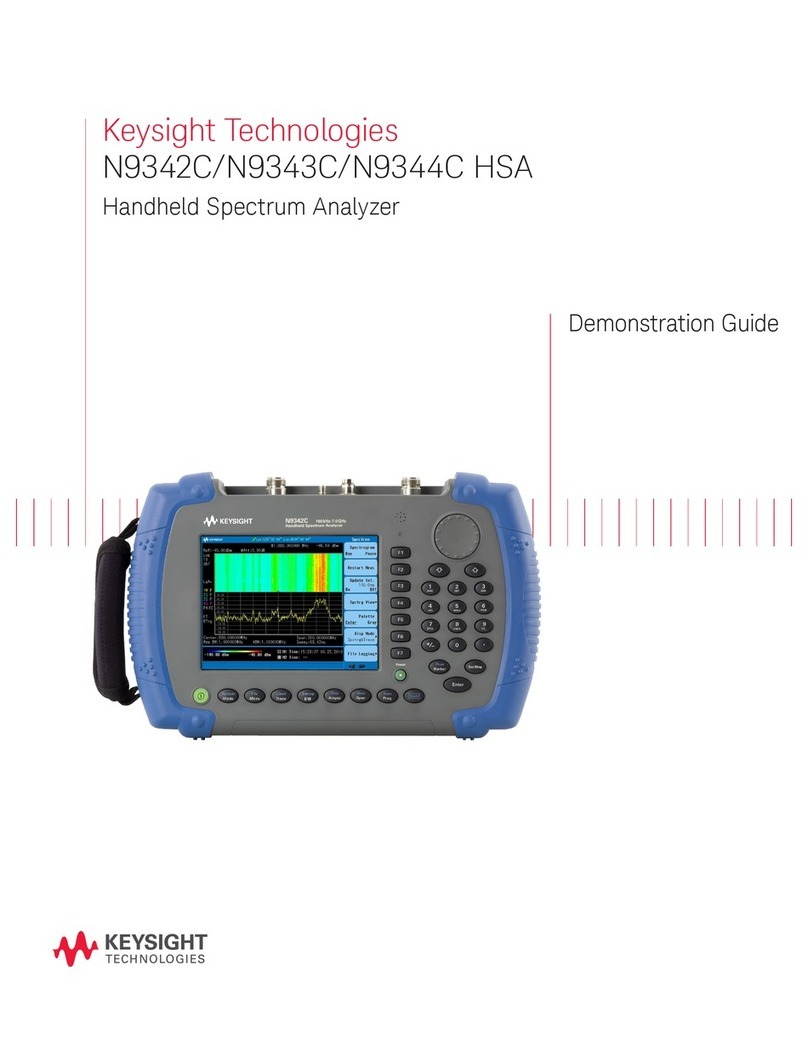
Keysight
Keysight HSA N9342C Demonstration Guide
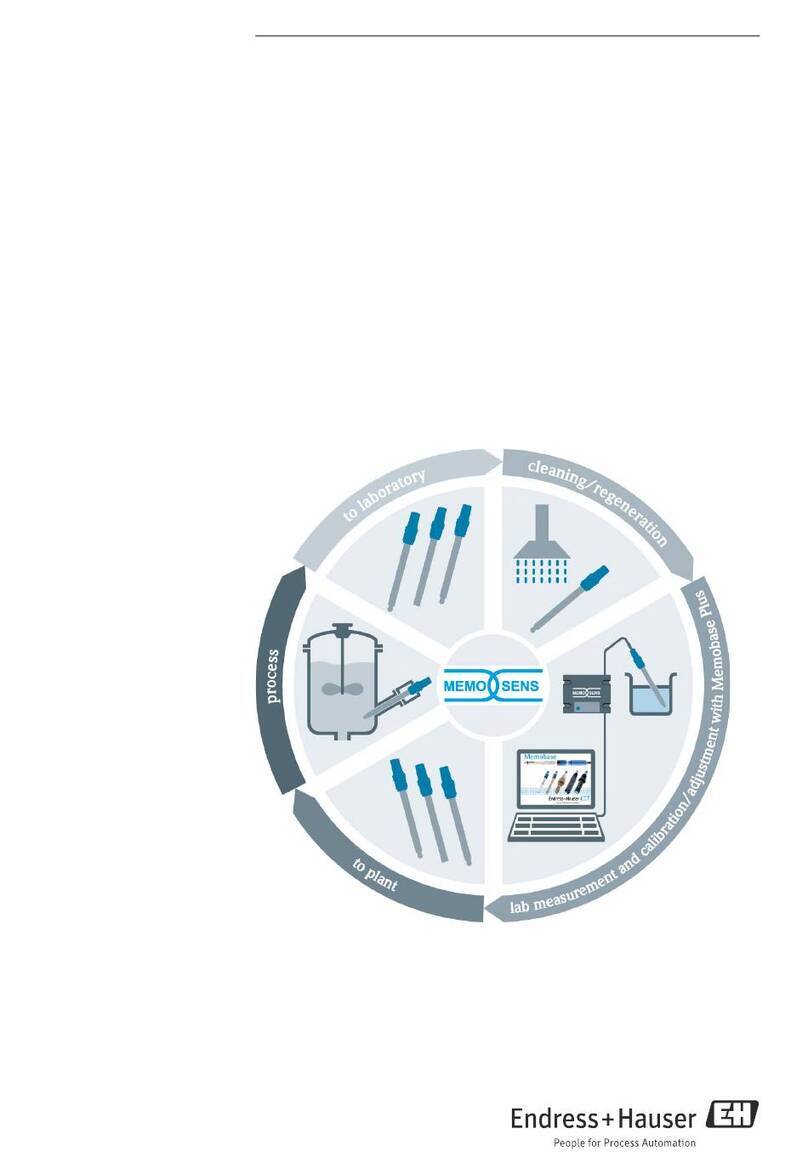
Endress+Hauser
Endress+Hauser Memobase Plus CYZ71D operating instructions
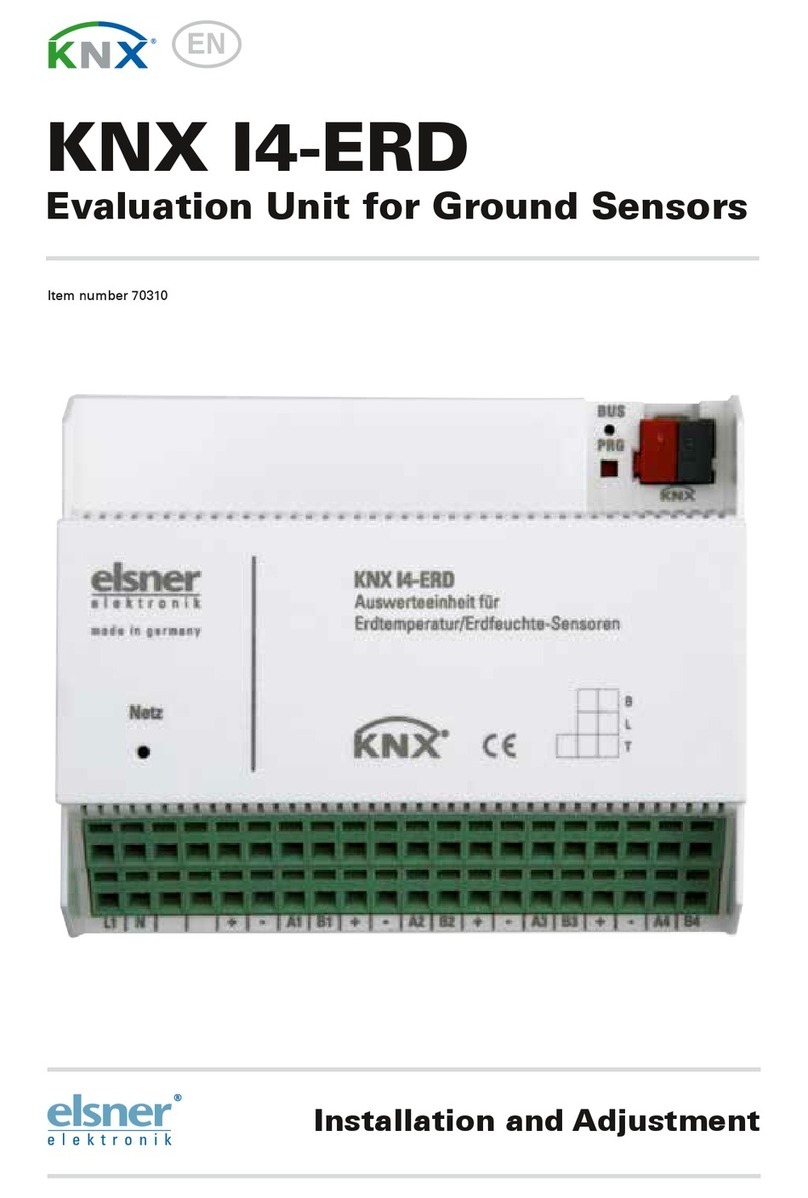
elsner elektronik
elsner elektronik KNX I4-ERD Installation and adjustment

SENSIT Technologies
SENSIT Technologies Trak-It IIIa GLT Quick start instructions

SPY
SPY DC POCKET JEEPMETER operating instructions

